Chapter 2
Single Event Effects: Mechanisms
and Classification
Re´mi Gaillard
Single Event Effects (SEEs) induced by heavy ions, protons, and neutrons become
an increasing limitation of the reliability of electronic components, circuits, and
systems, and have stimulated abundant past and undergoing work for improving our
understanding and developing mitigation techniques. Therefore, compiling the
knowledge cumulated in an abundant literature, and reporting the open issues and
ongoing efforts, is a challenging task. Such a tentative should start by discussing the
fundamental aspects of SEEs before reviewing the different steps that are necessary
for creating comprehensive prediction models and developing efficient mitigation
techniques.
SEE occurs when the charge resulting from the carriers (holes and electrons)
liberated by an ionizing particle (heavy ion, alpha particle, recoils of nuclear
interaction between a neutron and an atom of the die, . . .), and collected at a
junction or contact, is greater than the charge carrying an elementary information
in the component.
One way to understand the effects is to use a top-down approach to describe the
successive steps involved in the perturbation mechanism:
– Interaction of radiation with matter
– Ionization mechanisms and track structure
– Collection of charges
– Description and calculation of effects on semiconductor structure (junction,
device)
– Description and calculation of effects on semiconductor circuits and systems
The main difficulty is that each step is situated in a different physical/description
domain and involves different people with different skills (nuclear and solid state
physicists, process engineers, circuit designers, system engineers. . .). So bridges
R. Gaillard (*)
Consultant, Saint-Arnoult on Yvelines France
e-mail: remi.gaillard@iroctech.com
M. Nicolaidis (ed.), Soft Errors in Modern Electronic Systems,
Frontiers in Electronic Testing 41, DOI 10.1007/978-1-4419-6993-4_2,
# Springer ScienceþBusiness Media, LLC 2011
27
�
28
R. Gaillard
between these domains must be built to allow an efficient collaboration between
the experts mastering them.
This chapter presents a review of the main aspects of SEEs on digital electronics.
Analog and power electronics are not considered in this chapter.
2.1
Introduction
Single Event Effects (SEEs) are induced by the interaction of an ionizing particle
with electronic components. Ionizing particles can be primary (such as heavy ions
in space environment or alpha particles produced by radioactive isotopes contained
in the die or its packaging), or secondary (recoils) created by the nuclear interaction
of a particle, like a neutron or a proton with silicon, oxygen or any other atom of the
die. SEEs become possible when the collected fraction of the charge liberated by
the ionizing particle is larger than the electric charge stored on a sensitive node.
A sensitive node is defined as a node in a circuit whose electrical potential can be
modified by internal injection or collection of electrical charges. Usually, an
information bit is associated with a voltage level.
Today, these effects are considered as an important challenge, which is strongly
limiting the reliability and availability of electronic systems, and have motivated
abundant research and development efforts in both the industry and academia.
These studies involve a broad domain of physics such as natural radiation
environment modeling, radiation interaction mechanisms, ion energy depositions
in insulators and semiconductors, charge transport and collection in elementary
semiconductor devices such as PN junctions or elementary MOS transistors. The
studies involve also electronic engineers that analyze perturbation mechanisms and
effects in various cells (gates, flip-flops, registers, and memory cells), perturbation
effects in complex integrated circuits with the possibility of multiple errors and
single event functional interrupt (SEFI).
Designers must also consider analog components either CMOS or Bipolar that
can also be upset (operational amplifiers, regulators, comparators, oscillators).
Finally, system level engineers must investigate the global effects of single
events on electronic systems and develop mitigation techniques and test methods
to establish and verify the robustness of these systems.
The aim of this chapter is to describe the physical mechanisms that induce SEEs
and to define and classify the different ways they alter circuit operation. A top-down
presentation will be given from environment to effects in complex function.
First, the natural radiation environment at ground level and in the atmosphere
will be quickly recalled. A recall of nuclear physics, interaction mechanisms, and
energy deposition, is given.
Then, solid-state physics and semiconductor physics are considered in order
to develop transient photocurrent models related to the collection of carriers in
junctions.
Finally, the effects observed in electronic devices will be defined and classified.
�
2 Single Event Effects: Mechanisms and Classification
29
2.2 Background on Environment, Interaction Mechanisms,
and Recoil Energy Loss
2.2.1 Natural Radiation Environment
At high altitudes in the atmosphere and at ground level, nuclear radiation can be
found within a broad domain of energies. This radiation includes primary radiation
from galactic or extragalactic origin with a low flux and secondary radiation
resulting from the interaction of the primary radiation with the atmosphere content
(nitrogen, oxygen, carbon dioxide, rare gas).
When galactic cosmic ray (GCR) particles reach the earth’s atmosphere, they
collide with the nuclei of nitrogen and oxygen atoms and create cascades of
secondary radiation of different kinds, including leptons, photons, and hadrons.
At the time of writing this book, the neutrons are considered as the most
important source of radiation as far as SEEs are considered. Nevertheless, we
must also remember that protons and pions can also induce SEEs, and direct
ionization of protons may be a concern in future electronics as circuits are further
shrinking and become increasingly sensitive to SEE.
The flux of neutrons varies with altitude (the atmosphere attenuates both the
cosmic rays and the neutron flux), latitude (due to the variation of the earth’s
magnetic field shielding efficiency from equator to the poles), and to a lesser extent
with longitude. The flux of neutrons can be modulated by solar activity and solar
eruptions.
Recently, analytical models describing these variations have been presented in
Jedec JESD89A [1] and discussed in Chap. 3.
Measurements have been performed using different monitors or spectrometers.
The energy spectrum is generally considered to be independent of altitude. It
extends from thermal energies up to 10 GeV. In first approximation, the differential
energy spectrum dn/dE can be considered to be proportional to 1/E. This means that
we get about the same number of neutrons in the energy range 1–10 MeV,
10–100 MeV, and 100 MeV–1 GeV. For E > 1 GeV, the slope dn/dE can be
considered with a good approximation to be proportional to E
�2.
More precisely, the neutron spectrum has three major peaks, thermal energy
peak, evaporation peak around 1 MeV, and cascade peak around 100 MeV.
More information on the shape of the spectrum can be found in [2, 3]. The
recently developed QARM model is described in [4].
The reference flux is taken at New York City at sea level [1] to be 13 n/cm2 for
E > 10 MeV. More details are given in Chap. 3.
An other important contribution to soft errors comes from alpha particles
(helium nucleus built with two neutrons and two protons) emitted by radioactive
elements found at
trace levels in different materials close to the sensitive
nodes of the electronic devices. These alpha emitters are elements from the three
natural decay chains called Thorium, Radium, and Actinium decay chains. Secular
�
30
R. Gaillard
equilibrium1 is sometimes assumed, but this hypothesis may not apply in practical
cases if purification methods are applied to eliminate some elements in the radio-
active chain. The energy of alpha particles is in a domain between 3 MeV and
9 MeV. Alpha emitters from the Thorium decay chain are given in the following
table.
Elements
232Th
228Th
224Ra
220Rn
216Po
212Bi
Energy (MeV)
Half lifetime
4.08
1.41010 years
5.52
6.75 years
5.79
3.63 days
6.40
55.6 s
6.91
0.145 s
6.21
60.55 mn
212Po
8.95
299 ns
Important efforts are involved in reducing the impurities concentration and
characterizing the alpha emission rate from materials used in packaging. Alpha
sensitivity is calculated for a flux of 10
�3 alpha/cm2/h.
2.2.2 Neutron Interaction with Matter: Production
of Energetic Recoils
Neutrons can interact with the nucleus either by elastic and nonelastic interaction
and give a part of its energy as kinetic energy to the recoils. In some materials such
as 10B low energy neutron capture will give an exoenergetic reaction, but generally
energy is either conserved (elastic collisions) or a fraction of it is changed in mass
so that the total kinetic energy of the recoils is lower than the kinetic energy of the
incident neutron.
2.2.2.1
Interaction Probability
The interaction probability per nucleus is given by the cross-section expressed
usually in barn/nucleus. The cross-section is the effective area of the nucleus for
�24 cm2. In silicon, the total neutron
interaction with a neutron. One barn equals 10
cross-section decreases from 1.95 barn at E ¼ 40 MeV–0.6 barn at E ¼ 200 MeV.
To obtain the mean free path without interaction of neutrons in silicon, the
number n of nucleus per cm3 is first calculated. By considering the density d in
g/cm3, the atomic mass 28 g of 1 Avogadro of nucleus d ¼ 2.33 g/cm3, and
the Avogadro number N ¼ 6.02 � 1023, we find n ¼ 6.02�1023/(28/2.33) ¼
5 � 1022 A/cm3.
For an interaction cross-section value of one barn the mean free-range is:
�
�
1
10
�
�24 � 51022
¼ 20 cm:
1The state where the quantity of a radioactive isotope remains constant because its production rate
(due, e.g., to decay of a parent isotope) is equal to its decay rate.
�
2 Single Event Effects: Mechanisms and Classification
31
So, as it is well known, neutrons can cross an important thickness of matter
without interacting. The cross-section of interaction of one neutron with an energy
of about 100 MeV (with s ¼ 1 barn), in a small cube with a side of 1 mm is then:
V � n � s ¼ 10
�12 � 51022 � 10
�24 ¼ 510
�14 cm2:
This value gives the order of magnitude of the upset cross-section per bit that
will be obtained for SEU in SRAMs.
Because silicon is the main constituent of electronic devices, we can consider
that silicon is the main target material. But for more accurate estimations, we need
to take into account all the materials that may exist in the structure of an electronic
device. As it is discussed later, we need to consider all the recoils that may come
close to or pass through a sensitive node. These recoils must be produced at a
distance from the sensitive node that is lower than their range.
2.2.2.2 Elastic Interaction
In the elastic process, the recoil nucleus is identical to the target nucleus. In the
collision, the total kinetic energy and the momentum of the neutron-target nucleus
system are conserved. A fraction of the energy of the neutron is given to the
nucleus. The maximum energy that can be given to the recoil is:
Emax ¼ 4 � E �
A
A þ 1
ð
Þ2
;
where A is the atomic number of the target nucleus. The probability to give a given
energy between 0 and Emax is obtained by the differential elastic cross-section.
Most of the silicon recoils produced by elastic collisions have a low energy. For
example, with an initial neutron energy En
give a recoil with energy larger than 0.27 MeV and 0.1% give a recoil energy larger
than 1.5 MeV.
¼ 125 MeV, only 5% of the interactions
2.2.2.3 Nonelastic Interaction
Nonelastic interactions group all the interactions that result in a fragmentation
of the nucleus in two or more recoil fragments. Generally, the lighter recoil
is indicated to describe the reaction: (n,p), (n,a), (n,d). The heavier element is
obtained by the equilibrium of the number of neutrons and protons before and after
the reaction. With 28Si as the target nucleus, (n,p) reaction results in a proton and
Al recoil, (n,a) reaction results in He and Mg recoils.
The incident energy of the neutron diminished by the mass variation is shared
between the secondary particles and the main recoil nucleus. These reactions
require that the incident neutron energy is larger than the threshold energy of
�
32
R. Gaillard
each reaction. For a given neutron energy, different reactions are possible but their
relative probability varies with the neutron energy.
2.2.2.4
Inelastic Collision: (n,n
0
)
In this reaction, the incident neutron is absorbed in the target nucleus and a short
time later a neutron is ejected with a lower energy, sharing a part of the total kinetic
energy with the recoil target nucleus. The emission is considered to be isotropic.
Most of recoils with Er>2 MeV come from nonelastic collision as shown by
Chadwick [5, 6].
2.2.2.5 Pion Creation
Above about 250 MeV, neutrons can interact directly with nucleons in the silicon
nucleus to form pions. Charged pions lose energy through ionization and by
�28 s to form charged
reacting with additional silicon nuclei or decaying in about 10
secondary particles that also deposit charge in the silicon.
When more than two fragments are created, the repartition of energies and
angles can be difficult to evaluate (multibody reactions). More details are given
in Chap. 4.
2.2.2.6 Nuclear Data Base
The atmospheric neutron energy spectrum covers a broad energy range from meV
�3 eV) to 10 GeV. A detailed knowledge of the recoil products is needed to
(10
calculate the range and density of ionization. So the energy spectrum is divided in
different energy bins. For each neutron energy, the distribution of the nature and the
energy of the different recoils are calculated.
In this way, a database is built to allow further use by Monte–Carlo Sampling in
this distribution.
To build the database, a Monte–Carlo interaction code is needed. These codes
must calculate the energy and direction of all the recoils. Wrobel [7] has developed
the code MC-RED to develop such a data base. Chadwick [5, 6] has performed the
extension of MCNP code previously limited to 20–150 MeV.
Data bases must be built for all the materials that can be met in the vicinity of the
sensitive node. In each SEEs prediction codes, the data base is one of the most
important parts that define the precision of the prediction. Usually, Si and O target
nucleus are considered, but W used in vias and Cu used in metalization layers are
also considered.
Tukamoto [8] has detailed in such a way that database can be obtained in
the full spectrum energy domain. He used the JENDL-3.3 library to obtain the
double-differential cross-sections (DDXs) for light charged particles (p and a) and
�
2 Single Event Effects: Mechanisms and Classification
33
all recoils(24,25Mg, 27,28Al, and 27,28Si) in the n+ 28Si reaction at energies between
2 and 20 MeV. The data for energies between 20 and 150 MeV were taken from the
LA150 library [5, 6] in which the DDXs of all recoils are included. Tukamoto has
calculated the cross-sections for energies above 150 MeV using the QMD code [9]
plus statistical decay model (GEM [10]) calculation.
The total deposited energy, in terms of kinetic energy transferred to recoils, is
also an important parameter. This term was considered initially in the Burst
generation rate (BGR) method to predict the Soft Error Rate (SER) [11]. It
represents a worst case approach for SER calculation because all the energy
transferred to recoils is assumed to be transformed in ionization and totally col-
lected at the sensitive node.
The energies of the recoils are for a large part lower than 5 MeV.
If for 100 MeV neutrons, 28Si recoil due to nonelastic collision is considered, it
can be shown that 90% of the silicon recoils have their energy lower than 2.5 MeV
and 99% their energy lower than 5 MeV. But light particles such as He nucleus
(Alpha particles) have a higher energy. For 100 MeV neutrons, 10% of recoils have
their energy greater than 16 MeV, and 1% have their energy greater than 31 MeV.
For En ¼ 20 MeV, the emitted recoils are separated in light recoils (protons
(n,p), deutons (n,d), tritons(n,t), 3He, 4He (n,a)), and heavy recoils (21Ne, 27Al,
28Al, 24Mg, 25Mg, 26Mg, 28Si, 24Na). No recoils with 5 < A < 21 are produced. For
higher energies, most of the isotopes with A values from 1 to 28 are present.
The creation of a nuclear data base is one of the most important steps in
establishing a prediction tool to calculate the sensitivity of devices.
The nuclear data base gives also the angle of emissions when multiple particles
are generated in a single interaction. The energies and emission directions are
correlated to the incident neutron energy and direction.
A complete nuclear data base would give information on recoils resulting from
all the materials that are at a distance from the sensitive zone lower than the
maximum range of the recoils.
In particular recoils from oxygen (in SiO2), W used in plugs, Cu in metalization,
and also high K dielectrics used in the gate of MOS transistors, must be considered.
Their relative contribution to the SER of a device is related to the technology used
(number and thickness of metalization levels, structure of the cells, . . .).
One important problem is the way to use the important volume of data generated
in the data base and to calculate the sensitivity of the devices.
2.2.3 Recoils: Ionization and Ranges
The different recoils produced in an interaction extend from proton or neutron to the
nucleus of the target atom. Neutrons produced in the reaction are not considered
since their probability of interaction in the vicinity of their creation is very small.
The ions lose their energy by coulomb interaction with the electrons of the target
atoms and at the end of their range by elastic collisions with the atoms [48].
�
34
R. Gaillard
The energy loss as a function of energy is given by codes such as SRIM [12] or
MSTAR [13].
The most important parameters are the total or projected range of the ion, the
energy loss by unit length, the velocity of the ion and finally the transverse profile of
the ionization density in the ion track.
The ion range will determine the volume around a sensitive node where a
neutron interaction may create a recoil able to reach this node.
The energy loss per unit length gives the density of the electron-hole pairs that
can be collected in the space-charge layer and diffusion length of a PN junction
The transverse profile of the track is to be compared to the junction width or the
channel length of a device.
2.2.3.1 Ranges of Recoils
We must separate the light ions (alpha, protons) which have generally a higher
energy and a very long range from the heaviest ions (Si, Al, Mg). Range of silicon
recoils, in a silicon lattice, with an energy <10 MeV, calculated with SRIM2008
[12] is given below. For E < 5 MeV, the range is less than 3 mm.
This range is short but much larger than the dimensions of transistor dimensions
in recent technology nodes so that even heavy recoils can reach several sensitive
nodes (Fig. 2.1).
Silicon recoil Range (µm)
6
5
4
3
2
1
0
0
1
2
3
4
5
6
7
8
9
10
Fig. 2.1 Range of silicon recoil in a silicon lattice
Energy (MeV)
�
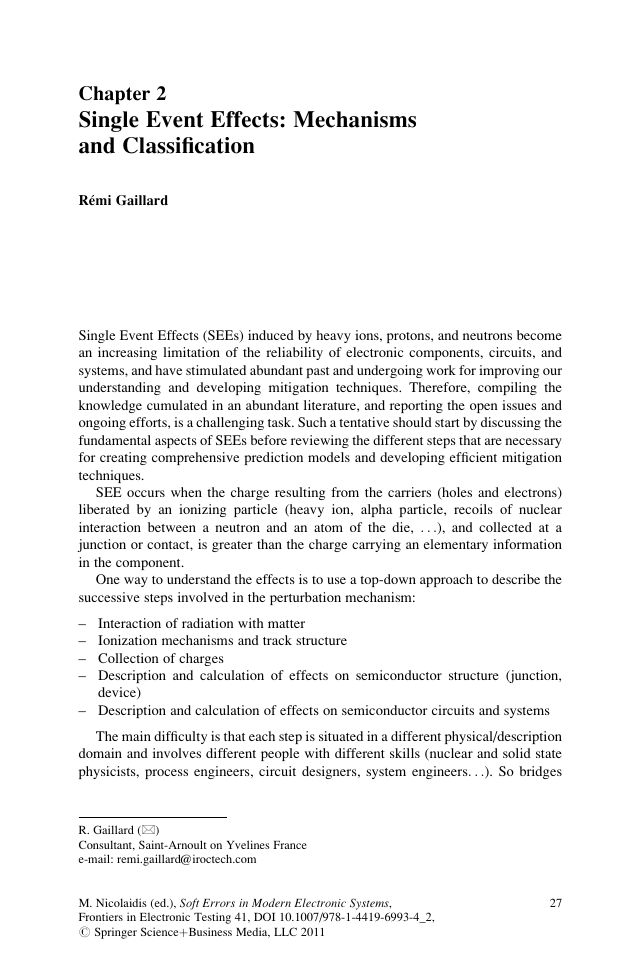
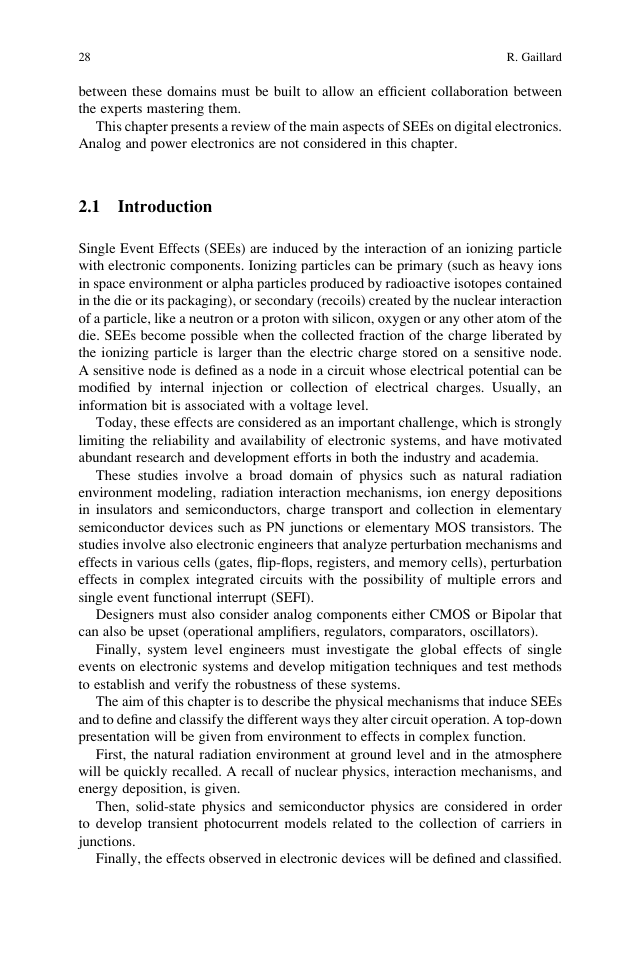
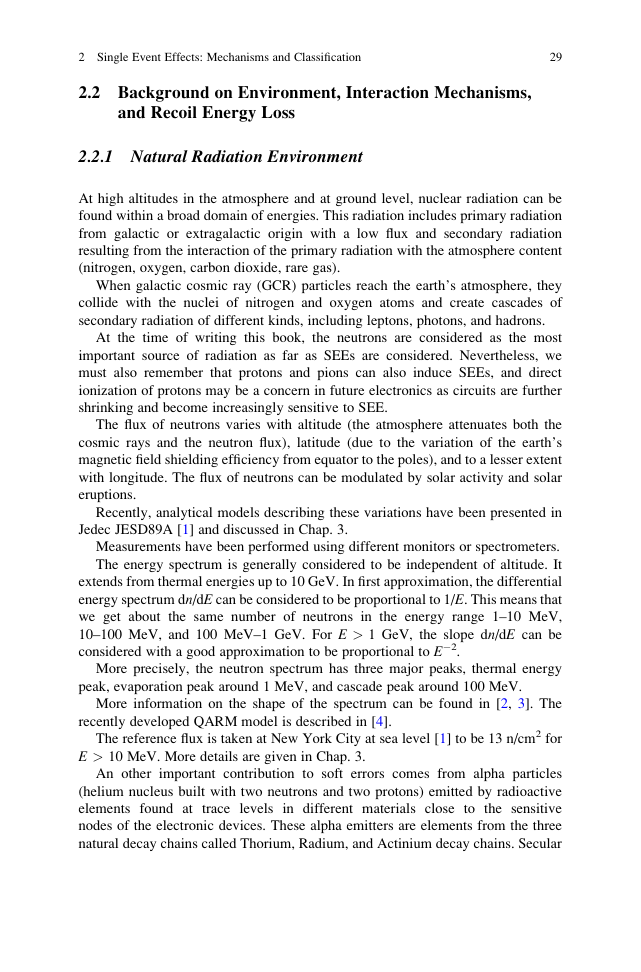

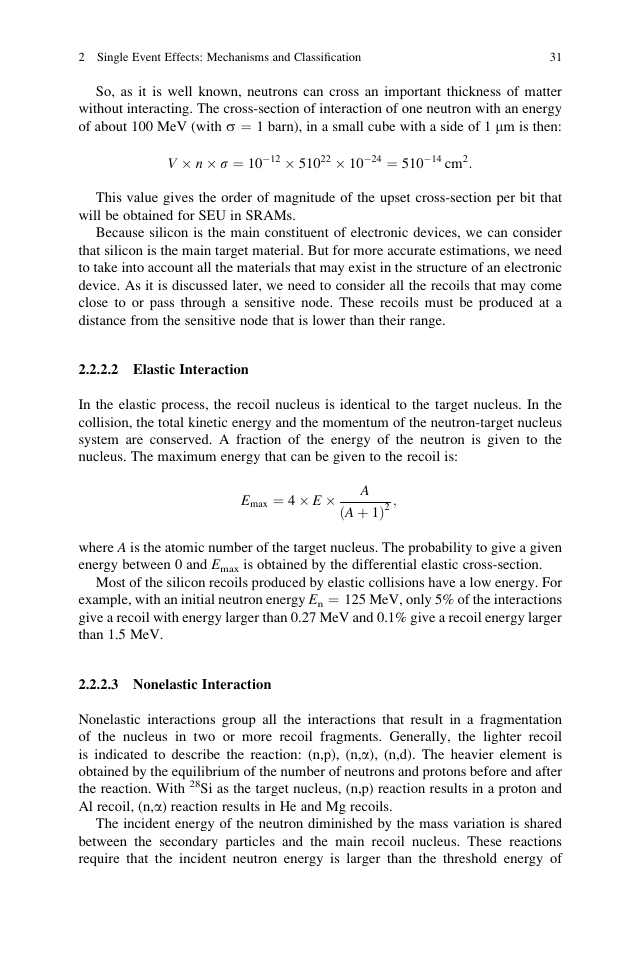
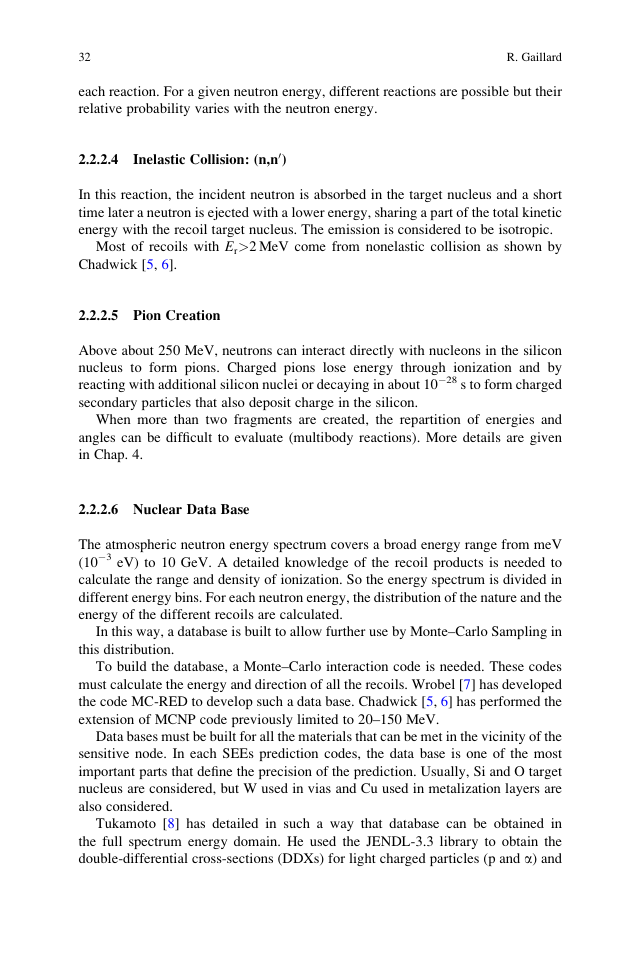
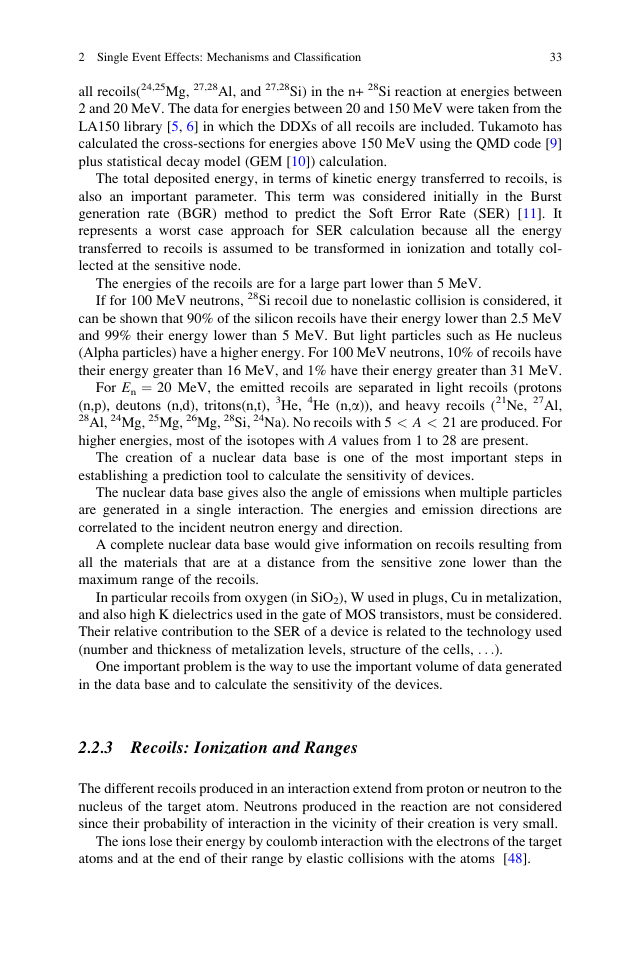
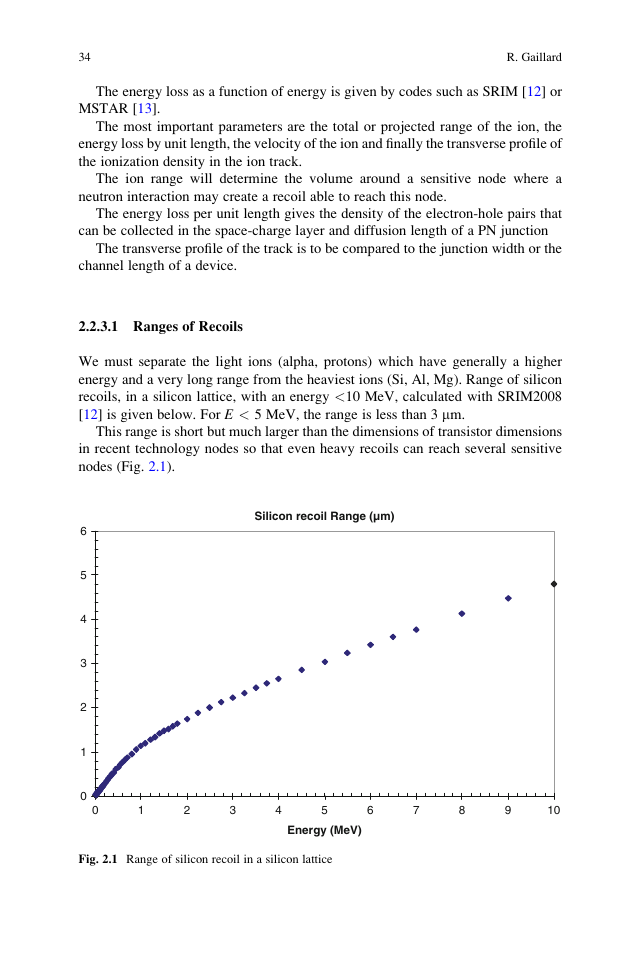








 2023年江西萍乡中考道德与法治真题及答案.doc
2023年江西萍乡中考道德与法治真题及答案.doc 2012年重庆南川中考生物真题及答案.doc
2012年重庆南川中考生物真题及答案.doc 2013年江西师范大学地理学综合及文艺理论基础考研真题.doc
2013年江西师范大学地理学综合及文艺理论基础考研真题.doc 2020年四川甘孜小升初语文真题及答案I卷.doc
2020年四川甘孜小升初语文真题及答案I卷.doc 2020年注册岩土工程师专业基础考试真题及答案.doc
2020年注册岩土工程师专业基础考试真题及答案.doc 2023-2024学年福建省厦门市九年级上学期数学月考试题及答案.doc
2023-2024学年福建省厦门市九年级上学期数学月考试题及答案.doc 2021-2022学年辽宁省沈阳市大东区九年级上学期语文期末试题及答案.doc
2021-2022学年辽宁省沈阳市大东区九年级上学期语文期末试题及答案.doc 2022-2023学年北京东城区初三第一学期物理期末试卷及答案.doc
2022-2023学年北京东城区初三第一学期物理期末试卷及答案.doc 2018上半年江西教师资格初中地理学科知识与教学能力真题及答案.doc
2018上半年江西教师资格初中地理学科知识与教学能力真题及答案.doc 2012年河北国家公务员申论考试真题及答案-省级.doc
2012年河北国家公务员申论考试真题及答案-省级.doc 2020-2021学年江苏省扬州市江都区邵樊片九年级上学期数学第一次质量检测试题及答案.doc
2020-2021学年江苏省扬州市江都区邵樊片九年级上学期数学第一次质量检测试题及答案.doc 2022下半年黑龙江教师资格证中学综合素质真题及答案.doc
2022下半年黑龙江教师资格证中学综合素质真题及答案.doc